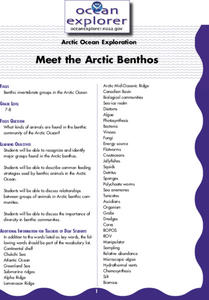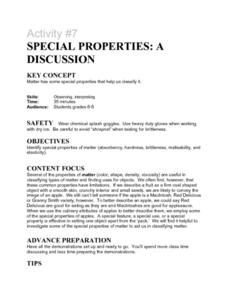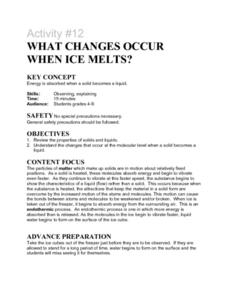Curated OER
Activity #17 Liquid Density and Temperature
Learners comprehend that hot water rises up through cold water but cold water does not rixe in hot water. They comprehend that water at temperatures above 4oC decreases in density with increases in temperature. Students answer lab...
Curated OER
Activity #6 'Nothing' Matters: A Demonstration
Students observe the 'pouring' of a gas. They compare the masses (weights) and densities of two gases. Pupils define the following terms: matter, mass, and density. Students answer questions after watching the demonstration.
Curated OER
Herd Management
Students examine herd management and career opportunities while working in groups. They analyze herd strengths and weakness as well as identify herd traits and other management factors through research. Individually students present a...
Curated OER
Light and Optics
Students discover the relationship between lens shape and the formation of images in an experiment. They use three different size converging lenses and a diverging lens to calculate and compare the focal length of each. They graph and...
Curated OER
Looking At the World Through Different Eyes
Students are introduced to the concept of reframing as a problem-solving alternative. They present the value of incorporating adults into their suport system. Students draw what they think Creep Face and Maggie saw when they looked...
Curated OER
Dream Machines
Students explore the modern applications of robots and create one of the five parts of a robot that could solve a hypothetical public works problem. They study about the use of robots for laying fiber-optics cable in New Mexico by...
Curated OER
Lights in the Deep
Students describe, compare, and contrast bioluminescence, fluorescence, phosphorescence, and chemiluminescence. They explain the role of three major components of bioluminescent systems. They ex
Curated OER
Meet the Arctic Benthos
Students recognize and identify major groups found in the Arctic benthos. They describe common feeding strategies used by benthic animals in the Arctic Ocean. They discuss relationships between
Curated OER
Yo-Yos, Tow-Yos and pH, Oh My!
Learners explore how hydrothermal vents are formed and where they are located on the ocean floor. They study how scientists use CTDs to locate hydrothermal vents.
Curated OER
Marine Debris
Students will perform experiments to examine if debris will float, or blow in the wind. They discuss the effects of these characteristics on marine debris.
Curated OER
Wisconsin Birds Lesson Plan
Students, during an outdoor hike, are taught about the different types of birds found in Wisconsin.
Curated OER
Ecosystems
Third graders create an ecosystem for red wiggler worms to observe as they work on a complete unit.
Curated OER
Life of An Island
Students identify the steps in the life cycle of an island. They label islands in the correct stage of their life cycle and illustrate the process themselves. They also review the concept of plate tectonics.
Curated OER
How Much Radon Is Around You?
Students examine the amount of radon in their home. They discover how it enters the home and how to properly seal off any route that is allowing radon to seep in. They calculate the amount of ventilation needed in their home to be safe.
Curated OER
Making a Mini-Landfill
Students create a mini-version of a landfill. They examine the materials they use everyday and determine if they decompose or not. They identify the materials as renewable or nonrenewable as well.
Curated OER
Forests
Fourth graders examine the impact forests have on our lives. They listen to the book "The Giving Tree" by Shel Silverstein, and brainstorm about how forests are important to us. In small groups they create a poster illustrating how the...
Curated OER
DENSITIES OF REGULARLY SHAPED SOLIDS
Students calculate the volumes of regularly shaped objects from measurements of their dimensions. They use several formulas and measure different objects to calculate the density, volume, and mass of the objects selected or assigned.
Curated OER
Activity # 13 Float or Sink?
Students have seen that solids, which are more dense than a liquid, that sinks in that liquid and solids, which are less dense than a liquid, that floats on that liquid. They use a metal boat to float in water. Pupils comprehend that...
Curated OER
Determining Liquid Densities
Middle schoolers practice determining liquid densities in a short, hands-on lab activity. Students use a graduated cylinder to measure out 100 milliliters of a liquid, find its mass using a balance, and record measurements in a data...
Curated OER
Activity #5 'Empty' Bag?
Students review that air is a form of matter. They investigate how air takes up space. Pupils comprehend that they cannot see air, it takes up space and has mass, therefore it is a form of matter. Students investigate how to show that...
Curated OER
Activity #7 Special Properties: A Discussion
Middle schoolers identify special properties of matter (absorbency, hardness, brittleness, malleability, and elasticity). They define the term matter. Pupils investigate some of the special properties of matter to aid in classifying...
Curated OER
Activity #9 A State Debate!
Students list individual properties of solids, liquids, and gases. They examine that some properties have more than one state of matter. Pupils consider whether shaving cream, is a solid, a liquid, or a gas, or some combination.
Curated OER
What Changes Occur When Ice Melts?
Students explore the physical process of melting. They observe melting ice and answer questions related to energy transfer during phase changes.
Curated OER
What Changes Occur When Water Freezes?
Learners investigate the changes that occur at the molecular level when a liquid becomes a solid. They freeze water in baby jars and observe the changes that occur in the process.

























